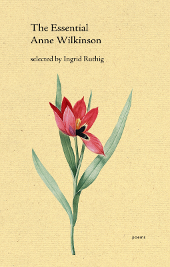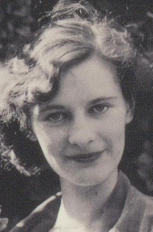The Porcupine's Quill
Celebrating forty years on the Main Street
of Erin Village, Wellington County
Instructor Resources
Lesson #1
The Essential Anne Wilkinson
A Guide by Ingrid Ruthig
Part 1: Close Reading

This exercise gives students an opportunity to ‘brainstorm’ and unpack a poem from The Essential Anne Wilkinson.
Student-to-student or as a group, read aloud each line of the poem "Theme and Variation" (reproduced below). Stress to students that there are no right or wrong answers, then encourage them to suggest all the possible meanings for words and phrases, line by line. Also, consider and discuss the various tools a poet might be using to bring the poem to life.
NOTE: Download a worksheet for this exercise in the Materials section below.
Theme and Variation
by Anne Wilkinson
This is the noisy silence of a tree
The rustle in the fern is the noise of fear
A twig is a nerve; it snaps the heart to pounding.
This is the swollen silence under the sea;
The hush and push of pressure soundless, sounding,
Drowning the human splash, the man-made tear.
This is the spiral’d silence in a cave
Where silence echoes itself; it echoes a jest
As a shell forever uncoils the thread of a wave.
This is the silence of love, and though the ear part
It cannot hear, it will not hear the rest,
The pause between compulsions of the heart.
—from The Essential Anne Wilkinson
(The Porcupine’s Quill, 2014)
- What images spring to mind? Which ‘collisions’ of words are unusual or unexpected?
- What do you hear—rhyme, rhythm, assonance, consonance, repetition, alliteration? Do words echo or mimic the sound of other things? What words seem to speed up or slow your reading?
- What other poetic devices are used? (metaphor, symbolism, allusion?)
- What do you sense from the words, as opposed to understand? What do you feel or imagine? How does it affect you? Does the poem call up a particular mood?
- What role does interpretation play? Might each reader connect on different levels? How?
- What does the poet show us that can’t be shown by any other means?

Part 2: Considering the Essential Poets
Each ‘essential’ poet has a unique Canadian voice, one through which s/he offers up observations about the world and who we are in it. Robyn Sarah, editor of the first volume in the series, writes: ‘I have interpreted "Essential" ... not as a suggestion that the greater part of the poet’s output might be dispensable, but as a challenge to identify those poems that best bear the essence of an individual poetic sensibility as it evolves over the length of a career and a life.’ Keeping these words in mind, answer the following questions:
- Why study this particular poet? Who was s/he? In what time period did s/he write?
- What does s/he document? What makes this poet’s voice different from others?
- Why examine these selected poems, chosen from the poet’s entire body of work?
Further Prompts for Discussing The Essential Anne Wilkinson (as they relate to the above questions):

- Anne Wilkinson was a Canadian poet in a time when those were few and far between;
- she wrote from a woman’s perspective, when those voices were still largely unheard and undocumented;
- her work reflects social, national, and gender history; how values of an earlier era were changing; and how an individual grew as her world changed;
- her work is still relevant. Her poetry connects with us through the universal—we all relate to and share this limited human experience, despite differences of era and background.
Part 3: The Broader Picture
Consider and discuss the following points:
- Canadian modernism as a poetic movement.
- What did it represent?
- Who was involved?
- How did it compare to the British or American modernist movement in poetry?
- Women writing and publishing in Canada in the first half of the 20th century.
- What elements worked against women writers, i.e. what did they have to overcome in order for their voices to be heard?
- Has anything improved in contemporary times? (Explore economic factors.
- Could they afford to write?
- How did/does raising a family and/or working at another job to make a living affect a poet’s output?)
- The works of those women. (e.g. P.K. Page, Margaret Avison, Anne Wilkinson.)
- What did their poetry explore?
- What forms did they use?
- What elements did they accept or reject of the work of poets who came before?
- Did the women’s voices differ from those of their male colleagues? How?
- Did they create something new? Change poetry?
- Anne Wilkinson, whose career was cut short by her early death, published only during the 1940s and 1950s. It is impossible to know how her work would have changed had she lived longer. However, we can look at Avison and Page, and examine their development as poets over a long life.
- Did their preoccupations and style of writing change?
- If so, in what ways?
- Why do you think that might be?
- Poetry offers other perspectives.
- In which ways is it important for us to be able to consider other views of life, our country, the world? (especially as documented by Canadian writers? women poets? by the modernists? or from other eras?)
- Consider the notion of relevance.
- What characteristics of any poet’s work contribute to its remaining relevant in contemporary times?

Part 4: Form and Function
Download the broadside "Theme and Variation" below and print/reproduce it to share in class. Consider the layout and design of the text and answer the following questions:
- Does typography change the way a poem is ‘read’?
- What about images?
- Colours?
- Can media (typography, images, colours etc.) affect the way an author’s words are understood, or misunderstood?
Materials

"Theme and Variation" Worksheet
21 KB

"Theme and Variation" Broadside
51 MB
The Porcupine's Quill would like to acknowledge the support of the Ontario Arts Council and the Canada Council for the Arts for our publishing program. The financial support of the Government of Canada through the Canada Book Fund (CBF) is also gratefully acknowledged.